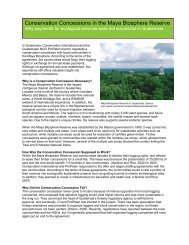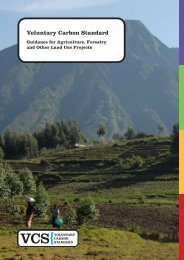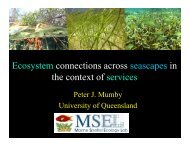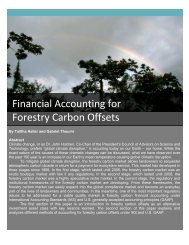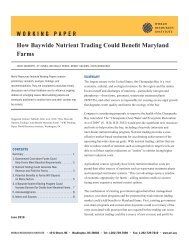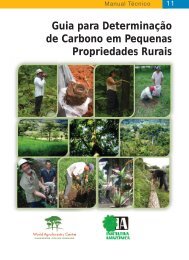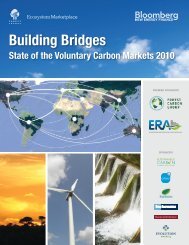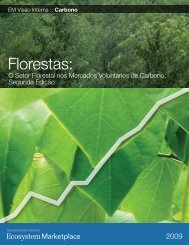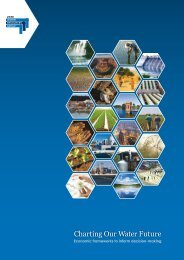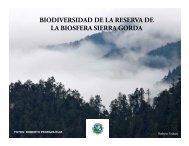Design of US Habitat Banking Systems to Support the Conservation ...
Design of US Habitat Banking Systems to Support the Conservation ...
Design of US Habitat Banking Systems to Support the Conservation ...
You also want an ePaper? Increase the reach of your titles
YUMPU automatically turns print PDFs into web optimized ePapers that Google loves.
APPENDIX ENew Mexico (Phase III)The State <strong>of</strong> New Mexico has no legislation, regulations,or guidance on wetland mitigation banking. Thestate does not participate in a Mitigation <strong>Banking</strong>Review Team.New York (Phase I)New York does not have state laws or regulations onwetland mitigation banking.The New York Department <strong>of</strong> Environmental<strong>Conservation</strong> (DEC) has developed general mitigationguidelines for its regula<strong>to</strong>ry staff. 123 The guidelines <strong>of</strong>fera framework for decision-making related <strong>to</strong> wetlandsregulation and enforcement, but only briefly mentionwetland mitigation banking. 124 In 2002, <strong>the</strong> DEC issueda memorandum <strong>to</strong> its field staff advising <strong>the</strong>m <strong>to</strong> considerbanking as mitigation option equivalent <strong>to</strong> o<strong>the</strong>r<strong>of</strong>f-site mitigation for freshwater wetlands. 125 The DECdoes not, however, support <strong>the</strong> use <strong>of</strong> banks for tidalwetlands. The state is also an active participant on<strong>the</strong> MBRT that covers activities in <strong>the</strong> New York andBuffalo Districts <strong>of</strong> <strong>the</strong> U.S. Army Corps <strong>of</strong> Engineers. 126The Adirondack Park Agency (APA) generally reviewsmitigation plans as part <strong>of</strong> <strong>the</strong> wetlands permittingprocess in cases where impacts <strong>to</strong> wetlands cannot beavoided, as well as mitigation resulting from enforcementactivities. In 1995, <strong>the</strong> agency adopted general mitigationguidelines that, similar <strong>to</strong> <strong>the</strong> DEC guidelines,recognize banking and in-lieu-fee as mitigation options,but do not prescribe specific methods for ei<strong>the</strong>r. 127123 New York Department <strong>of</strong> Environmental <strong>Conservation</strong>,Freshwater Wetlands Regulation - Guidelines on Compensa<strong>to</strong>ryMitigation, athttp://www.dec.ny.gov/docs/wildlife_pdf/wetlmit.pdf (Oct. 26, 1993).124 New York Department <strong>of</strong> Environmental <strong>Conservation</strong>,Freshwater Wetlands Regulation - Guidelines on Compensa<strong>to</strong>ryMitigation, at http://www.dec.ny.gov/docs/wildlife_pdf/wetlmit.pdf(last visited Sept. 12, 2007).125 Memorandum from Patricia Riexinger, New York Department <strong>of</strong>Environmental <strong>Conservation</strong>, Division <strong>of</strong> Fish, Wildlife and MarineResources, Bureau <strong>of</strong> <strong>Habitat</strong>, <strong>to</strong> Natural Resource Supervisors, NewYork Department <strong>of</strong> Environmental <strong>Conservation</strong> (Dec. 24, 2002) (onfile with author).126 Personal communication with Patricia Riexinger, N.Y. Dep’t <strong>of</strong>Envtl. <strong>Conservation</strong> (Nov. 12, 2003).127 Personal communication with Dan Spada, N.Y. Adirondack ParkAgency (May 10, 2004).North Carolina (Phase I)North Carolina has state laws and regulations thatguide wetland mitigation banking in <strong>the</strong> state. Thestate has established a comprehensive mitigationand res<strong>to</strong>ration program and operates a statewidein-lieu-fee program designed <strong>to</strong> consolidate wetlandand watershed mitigation and res<strong>to</strong>ration efforts. Both<strong>the</strong> North Carolina Ecosystem Enhancement Program(NCEEP) and <strong>the</strong> Division <strong>of</strong> Water Quality (DWQ) arelead state agencies for mitigation-related activities inNorth Carolina. DWQ is responsible for implementing<strong>the</strong> state’s regulations pertaining <strong>to</strong> mitigation andworks with applicants throughout <strong>the</strong> permit process,while <strong>the</strong> NCEEP provides options for parties thatneed <strong>to</strong> satisfy mitigation requirements. 128 The NCEEPstrategy involves <strong>the</strong> development <strong>of</strong> WatershedRes<strong>to</strong>ration Plans (WRPs), including <strong>the</strong> identification<strong>of</strong> Targeted Local Watersheds (TLWs) (14-digit hydrologicunits) within each 8-digit U.S. Geological SurveyCataloging Unit in <strong>the</strong> state. 129 Numerous o<strong>the</strong>r stateand federal agencies participate in <strong>the</strong> state’s MBRTand <strong>the</strong> Program Assessment and Consistency Group,a state-level group that operates similarly <strong>to</strong> <strong>the</strong> MBRT<strong>to</strong> support <strong>the</strong> NCEEP. 130128 Due <strong>to</strong> <strong>the</strong> stringency <strong>of</strong> <strong>the</strong> Coastal Area Management Act, <strong>the</strong>DCM does handle compensa<strong>to</strong>ry mitigation issues as regularly as <strong>the</strong>NCEEP and <strong>the</strong> DWQ.129 In 1998, <strong>the</strong> NCWRP completed Watershed Res<strong>to</strong>ration Plans(WRPs) for <strong>the</strong> 17 major river basins in <strong>the</strong> state. The WRPs includeres<strong>to</strong>ration goals, narrative overviews <strong>of</strong> <strong>the</strong> basins, priority subbasinmaps with water quality information, watershed boundaries,land cover data, information on existing water quality problems,descriptions <strong>of</strong> priority sub-basins, and wetland impact information.See North Carolina Wetlands Res<strong>to</strong>ration Program, NCWRPWatershed Res<strong>to</strong>ration Plans, at http://h2o.enr.state.nc.us/wrp/plans/wetrip.htm (last revised Jan. 25, 2004). The NCEEP’s WatershedNeeds Assessment Team (WNAT), an interagency group composed <strong>of</strong>representatives from several state and federal agencies, developeda “screening methodology” <strong>to</strong> identify Targeted Local Watersheds(TLWs) in which <strong>to</strong> concentrate planning and res<strong>to</strong>ration activities.Once TLWs have been identified through <strong>the</strong> screening methodology,<strong>the</strong> NCEEP will work with local governments, NGOs, and o<strong>the</strong>rstakeholders <strong>to</strong> complete local watershed plans in selected TLWareas throughout <strong>the</strong> state. See North Carolina Wetlands Res<strong>to</strong>rationProgram, Guide <strong>to</strong> <strong>the</strong> North Carolina Wetland Res<strong>to</strong>rationProgram’s Watershed Res<strong>to</strong>ration Strategy (April 2001), available athttp://h2o.enr.state.nc.us/wrp/pdf/restplans/Planning%20Guide.pdf.130 Personal communication with Suzanne Klimek, N.C. EcosystemEnhancement Program (Aug. 24, 2004).94 Environmental Law Institute



